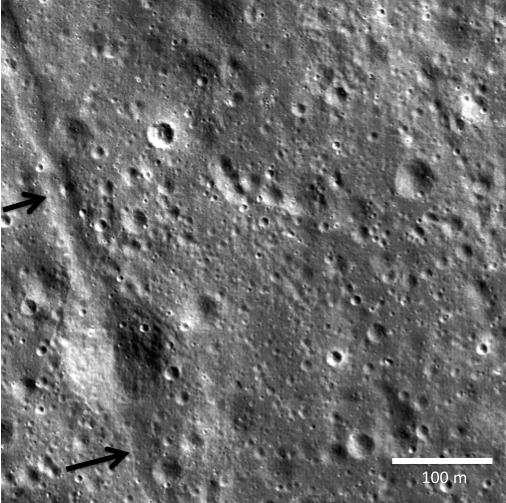
WIKIARCHIVES.SPACE
The Human Spaceflight Archive

Two small black arrows on today's image show the location of a small graben (28 meters or 30 yards in width) in a pyroclastic mantling deposit in the SW portion of Mare Humorum. A degraded impact crater (108 meters or 118 yards in diameter) can be seen centered on the graben between the arrows. The image width is 500 meters or 546 yards. NAC frame M111885077L obtained at an altitude of 44.7 kilometers or 72 miles, illumination is from the right.
Information
- Taken in
- Author
- NASA/GSFC/Arizona State University
- Description
-
Two small black arrows on today's image show the location of a small graben (28 meters or 30 yards in width) in a pyroclastic mantling deposit in the SW portion of Mare Humorum. A degraded impact crater (108 meters or 118 yards in diameter) can be seen centered on the graben between the arrows. The image width is 500 meters or 546 yards. NAC frame M111885077L obtained at an altitude of 44.7 kilometers or 72 miles, illumination is from the right.
NASA's Goddard Space Flight Center built and manages the mission for the Exploration Systems Mission Directorate at NASA Headquarters in Washington. The Lunar Reconnaissance Orbiter Camera was designed to acquire data for landing site certification and to conduct polar illumination studies and global mapping. Operated by Arizona State University, LROC consists of a pair of narrow-angle cameras (NAC) and a single wide-angle camera (WAC). The mission is expected to return over 70 terabytes of image data.
- Created on
- Friday 9 April 2010
- Albums
- US SPACE PROGRAM / PROBES / MOON / LRO/LCROSS / Mission Photos (Edited)
- Source link
- https://photojournal.jpl.nasa.gov
- Visits
- 16
- Rating score
- no rate
- Rate this photo
- License
- Public Domain
- Modified by WikiArchives
- No (original)
- Downloads
- 0
Powered by Piwigo































































































